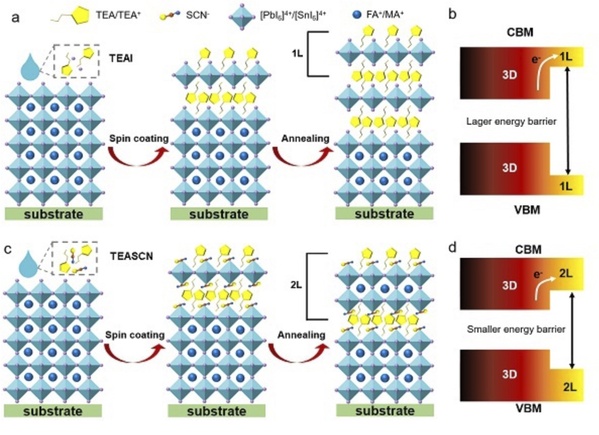Compared with traditional solar cells, perovskite solar cells have the characteristics of high efficiency and low cost, and are considered to be the most promising next-generation solar cells. However, the widely used lead perovskite material has a wide band gap, which limits its theoretical maximum efficiency. In recent years, tandem solar cells based on the superposition of wide-bandgap and narrow-bandgap perovskite cells have gained a lot of attention due to their high theoretical photoelectric conversion efficiency. For perovskite tandem batteries, the preparation of high-efficiency narrow-bandgap batteries with a tin-lead hybrid structure is extremely critical.
Although the band gap of the tin-lead hybrid structure is narrow, its efficiency is much lower than that of lead perovskite cells. In addition, the surface of the three-dimensional perovskite is prone to defects, and the divalent tin is easily oxidized, which further increases the defects on the surface of the perovskite film and affects the device performance. The formation of surface low-dimensional structures by post-treatment with ammonium halide salts is a common strategy to passivate the surface defects of perovskite films. However, the number of layers of the low-dimensional structures prepared by this method is difficult to control, especially the single-layer structure has a large band gap, which makes the carrier transport at the interface need to cross a higher potential barrier. Therefore, the combination of comprehensive surface passivation and efficient interfacial carrier transfer is the key to fabricate efficient tin-lead hybrid perovskite solar cells.
In order to solve the above problems, SPST Associate Professor Ning Zhijun's team synthesized 2-thiopheneethylamine thiocyanate (TEASCN), a new salt for the precise construction of bilayer quasi-two-dimensional on the surface of tin-lead mixed perovskite structure. Compared with the monolayer structure formed by common 2-thiopheneethylamine iodide (TEAI), the bilayer structure produced by TEASCN has a lower formation energy, which can form a monolayer structure first on the surface of the perovskite and transform during the annealing process to a more stable and uniform double-layer structure.

Schematic diagram of the structural evolution and corresponding energy level structure of TEAI salt and TEASCN salt in the treatment process of tin-lead mixed perovskite thin film, respectively
Compared with the single-layer structure, the double-layer structure can not only effectively passivate the defects on the perovskite surface, but also effectively reduce the charge transfer barrier and achieve efficient carrier transport. As a result, the open-circuit voltage and fill factor of the device are greatly improved without sacrificing the short-circuit current density, and the third-party certified efficiency reaches 21.1%. The study also revealed the formation mechanism of the bilayer structure through theoretical calculations, which provided a reference for the precise regulation of the quasi-two-dimensional perovskite structure.
The results were published in the international journal Angewandte Chemie International Edition. Doctoral students Yu Danni and Wei Qi are the co-first authors, Prof. Ning Zhijun is the corresponding author.

